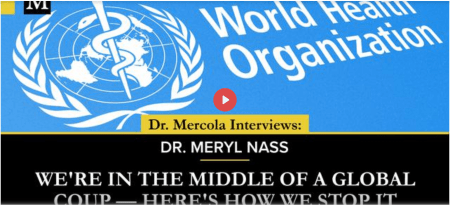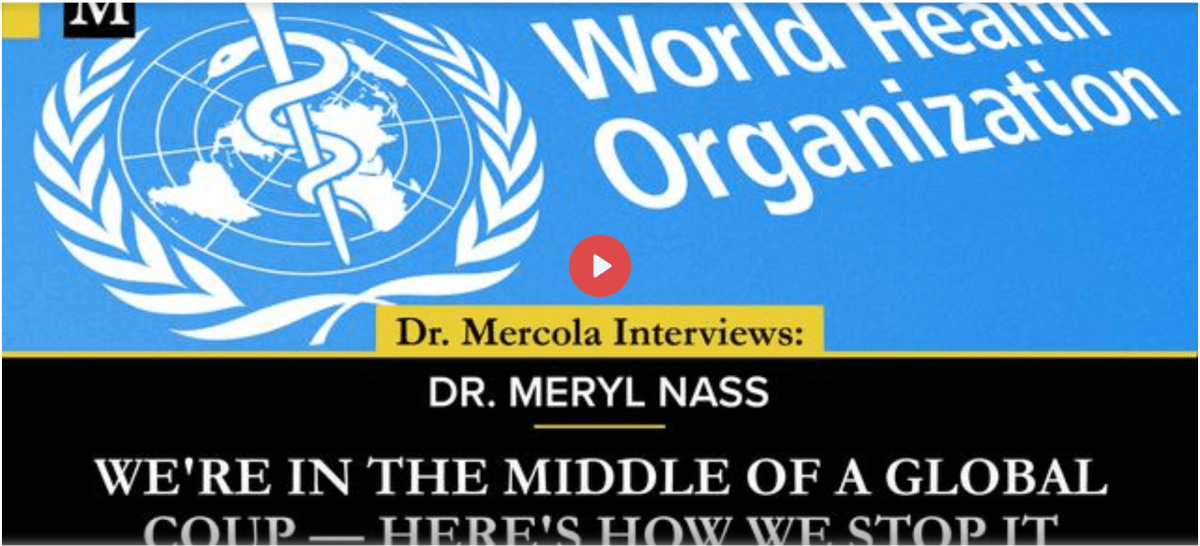
(Dec. 17, 2023) — In this interview board-certified internist and biological warfare epidemiologist Dr. Meryl Nass discusses the dangers posed by the World Health Organization’s upcoming pandemic treaty and the International Health Regulation (IHR) amendments. She also wrote about this in a recent article titled “The WHO’s Proposed Treaty Will Increase Manmade Pandemics.”1
“I’ve been reading the different drafts of the amendments and the Pandemic treaty that have been put forward,” she says. “They’re a mix of things, different ideas put forward by the different [member] countries. And then there’s a group within the WHO that tries to harmonize them, and also make sure that what the WHO wants is in them.
I had finally read through, line by line, the June 2nd, most recent draft of a pandemic treaty, and it had things that were much worse and more explicit in it than before, and I felt compelled to start writing about it.
Then, after I’d written a short piece, I realized it was too important and I needed to write a long piece with background and links, and try to get the message out to a lot of people.
Because the only reason these documents and the plan — the biosecurity agenda through the pandemic treaty and the International Health Amendments — have gotten as far as they have is because nobody has read them. [People] don’t understand what the plan is, and may not understand the backstory.”
Converging Agendas With Identical Goals
It’s important to realize that many different aspects of the grand plan are being put into motion by a variety of sectors and globalist organizations at the same time, and while they may appear independent of each other, they’re all leading us in the same direction, toward a unified goal, namely the enslavement of mankind and the centralization of control over the world’s population.
We have development of a new financial apparatus involving the rollout of a central bank digital currency (CBDC), for example.
“At the same time, the U.N. also wants into the action,” Nass says. “It wants to be able to declare global shocks and manage them. And those could be the ones that the WHO wants to manage, which is biological warfare and pandemics that occur in more than one country.
So, the U.N. has listed those two, but also all sorts of other potential global shocks, like climate change, supply chain interruptions, cyber events, and even events in outer space. And they finalize it with black swan events, which means anything the U.N. wants to designate as a global shock can be one, and then the U.N. will come out with its management of that event.
So, the secretary general of the U.N. is asking its members … at the annual meeting of the U.N. General Assembly, to give it permission to create this global emergencies platform … which will give the secretary general and the U.N. authority to manage global shocks.
Also at that meeting, the WHO and the U.N. are coming together to try to divvy up how things are going to go for biological warfare and pandemics that affect more than one country. So, look for information coming out on that on September 20.”
Why Was the Pandemic Treaty Introduced?
The WHO proposed the initial plan to grant itself the power to issue global emergency instructions in 2021. The claim was that nations had handled the COVID pandemic so poorly, we need a centralized organization to manage the next pandemic better.
“Of course, it was laid out in terms of equity, like the rich countries didn’t give the poor countries enough vaccines, etc … and so many people died. What is never said is that, in fact, almost all the countries of the world were following the WHO’s guidance, and that is what caused this last pandemic to be so devastating.
The economic implications were all as a result of the lockdowns, the resulting supply chain interruptions, the closure of schools, etc. So, although the WHO wants this great power, it hasn’t said that it’s going to do anything differently.
Nobody at the level of the WHO, the U.N., or the United States public health authorities or the president has said they did anything wrong. What they want to do is more of the same, and I mean more, lots more,” Nass says.

Download this Article Before it Disappears
WHO Wants To Be a Centralized Ruler of All
For example, they want to put into law the requirement that nations must censor their citizens, so that only public health messages aligned with the WHO’s recommendations can be shared. Already, YouTube has announced they will henceforth censor all health information that does not conform to the WHO’s narrative. But that censorship is nothing compared to what’s to come.
The amendments to the International Health Regulations (IHRs) also specify that the WHO will dictate which drugs countries must use, and which they cannot, in the event of a pandemic — and possibly outside of pandemics as well. As explained by Nass:
“The pandemic treaty … is a completely new document, and each draft has been different than the one before. In the current draft, the director general of the WHO doesn’t even need to declare a pandemic. The pandemic treaty will be in effect all the time.”
The IHRs have been in existence since 1969, but in the current draft of the IHR amendments, the WHO’s recommendations become edicts that must be followed rather than recommendations that nations can ignore at will.
In their current form, the amendments do require the director-general of the WHO to declare a public health emergency of international concern (PHEIC) before he can start giving orders, but there are no standards for what a PHEIC is. It could be anything. He would also have the power to declare a “potential” pandemic, even with limited or no evidence.
All Vaccines Will Be Fast-Tracked and Untested
The treaty also demands the fast-tracking of vaccines, along with liability waivers for vaccine manufacturers. According to Nass, the EU, U.S. and CEPI have already proposed a plan to develop vaccines in 100 days and manufacture enough for everyone in the country in another 30 days.
Read the rest and see the interview here for a limited time.

